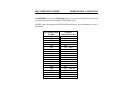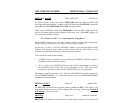
MFJ-1278B MULTI-MODE OPERATIONAL COMMANDS
Parameters:
n 0 - 3, selecting a parity option from the table below.
This command sets the word parity mode for the terminal or computer data transfer according
to the following table:
n Value
Parity
0 no parity
1 odd parity
2 no parity
3 even parity
The parity bit, if present, is automatically stripped on input and not checked in Command
Mode and Converse Mode. In Transparent Mode, all eight bits, including parity if any, are
transmitted in packets. If "no parity" is set and AWLEN is 7, the eighth bit will be set to 0 in
Transparent Mode.
PASS n Mode: Packet Default: $16
Parameter:
n 0 - $7F, specifying an ASCII character code.
This command selects the ASCII character used for the "pass" input editing command. The
parameter n is the ASCII code for the character you want to type in order to include the
following character in a packet or text string. You can enter the code in either hex or
decimal.
You can use this character to send any character in packets, even though that character may
have some special function. For example, suppose you have set COMMAND 3, specifying
that <CTRL-C> is your Command Mode entry character. If you use a Bulletin Board
program that requires a <CTRL-C> to escape from some operation, you will type
<CTRL-V> <CTRL-C>
to insert a <CTRL-C> character in your packet. Of course, if you do this frequently you
would be better off to change your Command Mode entry character. The default PASS
character is <CTRL-V>.


















